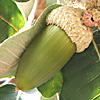Boissier Oak is a deciduous tree that reaches a height of 10 meters or more. The leaf arrangement is alternate. The leaves are carried on a short petiole. Their margins are dentated into triangular points, somewhat rounded at their end. The upper side of the leaves is glabrous. The lower side of the young leaves is covered with hairs (hirsute), and becomes glabrous as they mature. The hairs come off with slight rubbing of the fingers, which is a convenient distinctive mark of this species.
Quercus boissieri blooms during the months of March-April. The flowers are single-sex, the trees are monoecious. Pollination occurs by wind. The male inflorescences are limp catkins. The female flowers are tiny, arranged singly or in pairs on short pedicles. The acorns are elongated ovate, single or in pairs, with a length of 3-4 cm. The acorn is thinner and longer than that of all other oak species in Israel. The cupule is very short, and usually envelops less than a quarter of the length of the acorn. The scales of the cupule are short, obtuse, tightly attached to the wall of the cupule. The acorns develop over six months.
Quercus boissieri grows in forests and Maquis of the Mediterranean mountain range, usually at an elevation above 800 meters, in an association with Rubus canescens. It can be found on limey as well as basalt soil. Its distribution is East Mediterranean and West Irano-Turanian. Tannins for tanning leather were extracted from its bark. The trees are often infected by galls of many types of insects. This is the origin of its former scientific name and the Hebrew name of this species (tola [worm] also means a red color, because a red dye was produced from the galls). In Latin it is named after the Swiss botanist Pierre Edmond Boissier, who studied the Middle East flora in the 19th century.
Trees of the Quercus (oak) genus are among the most important trees in the world. Some call the oak “King of the Trees”. The genus contains 450 species, 5 of which grow in Israel. Of these two grow only on Mount Hermon. Some oaks are quite tall, with broad crowns and are long-lived. Oak species are common as the dominant trees in deciduous forests of temperate and cold regions in the Northern Hemisphere, and in evergreen forests in Mediterranean regions. The Hebrew name is derived from Providence, and is often mentioned in the Bible as a symbol for strength, as a place of worship and as raw material for sculpting and for industry (oars).
The leaves of all the species of this genus are dentate or emarginated. Most have leaves that are larger than those of the Israeli species. The flowers are tiny, green, not prominent, pollinated by wind. The flowers are single-sex, the trees are monoecious. The fruit contains a single large seed (acorn), enveloped in its lower part by a lignified cup-like structure called a cupule. The tree blooms in early spring, and its fruits ripen in the following autumn or in the autumn of the following year.
Oaks are the most important source of wood that is heavy, hard and dense, strong and resistant to pressure. Its wood is used in art for sculpting statues and ornamentation, for furniture, construction, industry and for the production of coal. The Arabs of Israel used oak branches to make a shank for the plough, a yoke for the ox and a cane for the elderly. There is nothing like oak wood for improving the taste of wine. Materials for curing leather are extracted from the oak. The thick bark of a west Mediterranean species of oak is the source for the cork used for production of bottle stoppers. Different species of oak are used in folk medicine. The acorns of some species are eaten in times of need as “poor-men’s bread” after roasting. Oaks are also known as important ornamental trees. However, in Israel this use is limited.
The oak has 2n=24 chromosomes. The different species are very similar to each other. Another difficulty in differentiating between the species is the great diversity in the shape of the leaf, the trunk and the fruit within populations of the same species.
Written by Erga Aloni and Mike Livne




